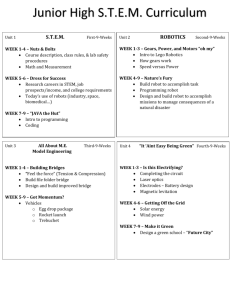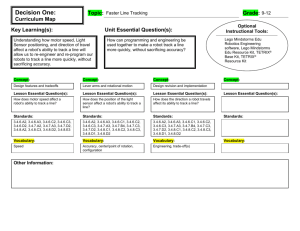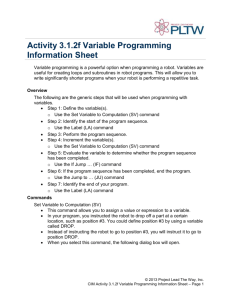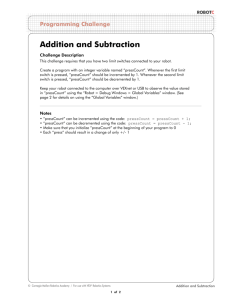2 The kinematics model of the parallel surgical robot
advertisement
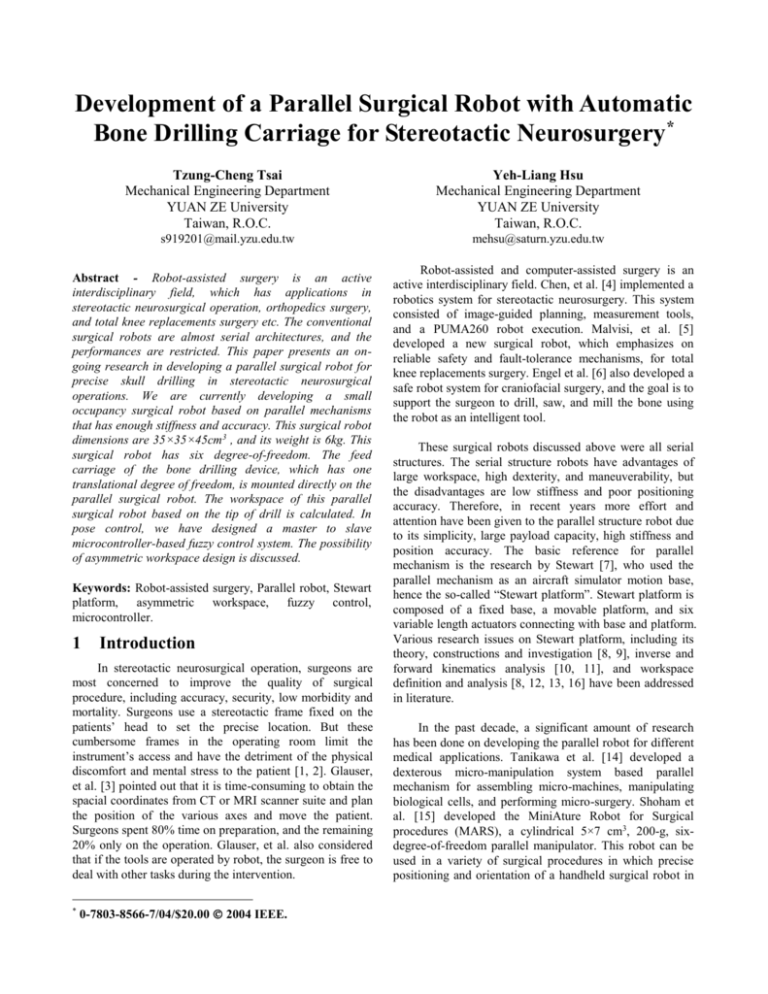
Development of a Parallel Surgical Robot with Automatic
Bone Drilling Carriage for Stereotactic Neurosurgery*
Tzung-Cheng Tsai
Mechanical Engineering Department
YUAN ZE University
Taiwan, R.O.C.
Yeh-Liang Hsu
Mechanical Engineering Department
YUAN ZE University
Taiwan, R.O.C.
s919201@mail.yzu.edu.tw
mehsu@saturn.yzu.edu.tw
Abstract - Robot-assisted surgery is an active
interdisciplinary field, which has applications in
stereotactic neurosurgical operation, orthopedics surgery,
and total knee replacements surgery etc. The conventional
surgical robots are almost serial architectures, and the
performances are restricted. This paper presents an ongoing research in developing a parallel surgical robot for
precise skull drilling in stereotactic neurosurgical
operations. We are currently developing a small
occupancy surgical robot based on parallel mechanisms
that has enough stiffness and accuracy. This surgical robot
dimensions are 35×35×45cm3 , and its weight is 6kg. This
surgical robot has six degree-of-freedom. The feed
carriage of the bone drilling device, which has one
translational degree of freedom, is mounted directly on the
parallel surgical robot. The workspace of this parallel
surgical robot based on the tip of drill is calculated. In
pose control, we have designed a master to slave
microcontroller-based fuzzy control system. The possibility
of asymmetric workspace design is discussed.
Keywords: Robot-assisted surgery, Parallel robot, Stewart
platform, asymmetric workspace, fuzzy control,
microcontroller.
1
Introduction
In stereotactic neurosurgical operation, surgeons are
most concerned to improve the quality of surgical
procedure, including accuracy, security, low morbidity and
mortality. Surgeons use a stereotactic frame fixed on the
patients’ head to set the precise location. But these
cumbersome frames in the operating room limit the
instrument’s access and have the detriment of the physical
discomfort and mental stress to the patient [1, 2]. Glauser,
et al. [3] pointed out that it is time-consuming to obtain the
spacial coordinates from CT or MRI scanner suite and plan
the position of the various axes and move the patient.
Surgeons spent 80% time on preparation, and the remaining
20% only on the operation. Glauser, et al. also considered
that if the tools are operated by robot, the surgeon is free to
deal with other tasks during the intervention.
*
0-7803-8566-7/04/$20.00 2004 IEEE.
Robot-assisted and computer-assisted surgery is an
active interdisciplinary field. Chen, et al. [4] implemented a
robotics system for stereotactic neurosurgery. This system
consisted of image-guided planning, measurement tools,
and a PUMA260 robot execution. Malvisi, et al. [5]
developed a new surgical robot, which emphasizes on
reliable safety and fault-tolerance mechanisms, for total
knee replacements surgery. Engel et al. [6] also developed a
safe robot system for craniofacial surgery, and the goal is to
support the surgeon to drill, saw, and mill the bone using
the robot as an intelligent tool.
These surgical robots discussed above were all serial
structures. The serial structure robots have advantages of
large workspace, high dexterity, and maneuverability, but
the disadvantages are low stiffness and poor positioning
accuracy. Therefore, in recent years more effort and
attention have been given to the parallel structure robot due
to its simplicity, large payload capacity, high stiffness and
position accuracy. The basic reference for parallel
mechanism is the research by Stewart [7], who used the
parallel mechanism as an aircraft simulator motion base,
hence the so-called “Stewart platform”. Stewart platform is
composed of a fixed base, a movable platform, and six
variable length actuators connecting with base and platform.
Various research issues on Stewart platform, including its
theory, constructions and investigation [8, 9], inverse and
forward kinematics analysis [10, 11], and workspace
definition and analysis [8, 12, 13, 16] have been addressed
in literature.
In the past decade, a significant amount of research
has been done on developing the parallel robot for different
medical applications. Tanikawa et al. [14] developed a
dexterous micro-manipulation system based parallel
mechanism for assembling micro-machines, manipulating
biological cells, and performing micro-surgery. Shoham et
al. [15] developed the MiniAture Robot for Surgical
procedures (MARS), a cylindrical 5×7 cm3, 200-g, sixdegree-of-freedom parallel manipulator. This robot can be
used in a variety of surgical procedures in which precise
positioning and orientation of a handheld surgical robot in
the vicinity of a rigid bony structure. Merlet [17] developed
a micro robot called MIPS with a parallel mechanical
architecture having three degrees of freedom (one
translation and two orientations) that allows fine
positioning of a surgical tool. The purpose of MIPS is to act
as an active wrist at the tip of an endoscope and to provide
to the surgeon an accurate tool that may further offers a
partial force-feedback.
The authors developed a modular mechatronic system
for automatic bone drilling in orthopedic surgery [18, 19].
One of the major objectives of this research was to develop
“add-on” devices that are compatible with current DC
motor-driven drills that are commercially available. This
system has undergone extensive drilling test on real human
skulls under various cutting conditions. There were no
unexpected failure, and the overshoots of all drilling tests
were less than 2mm. This system has three major modules:
the control unit, the feed carriage, and the supporting arm
as shown in Figure 1. The control unit consists of a control
box and a PC. The control box supplies power to the drill,
and in the mean time, the electric current consumed by the
DC motor of the drill is analyzed. The feed carriage is
designed to be a hand tool for the surgeon to hold with both
hands to perform drilling operation. The feed carriage can
be attached to a supporting arm that has three joints proving
five degrees of freedom. The supporting arm is a passive
device. The surgeon can manually move the feed carriage
to a given angle, and tighten the joints by simply turning a
knob. These joints are held solid by hydraulic force. The
arm has an electric magnetic base, which intends to
eliminate vibration and movement.
Following the development of the modular
mechatronic system, this paper presents a parallel surgical
robot that replaces the passive supporting arm of the
automatic bone drilling device. The working prototype is
shown in Figure 2. The dimensions of this robot are
35×35×45cm3, and its weight is about 6kg. The feed
carriage of the bone drilling device, which has one
translational degree of freedom, is mounted directly on the
parallel surgical robot. This small occupancy surgical robot
is based on the parallel mechanisms structure that has six
degree-of-freedom to provide enough stiffness and accuracy.
The pose controller controls the parallel surgical robot,
carrying the feed carriage and the drill, to the pre-defined
drilling position with correct orientation automatically.
Then surgeon can operates the drill for drilling operation.
Fig. 1. A modular mechatronic system for automatic bone
drilling
Drill
Feed carriage
Simulated skull
Parallel robot
Pose controller
Fig. 2. Parallel surgical robot
This paper is organized as follows. Section 2 presents
the kinematics model of the parallel surgical robot. The
asymmetric workspace of this parallel surgical robot is
analyzed in Section 3. Section 4 introduces the pose
controller for parallel surgical robot. At last, Section 5
concludes this research.
2
The kinematics model of the parallel
surgical robot
The parallel surgical robot developed in this research
is shown schematically in Figure 3. It is a six-degree-offreedom UPS (universal-prismatic-spherical) mechanism,
and there is an additional translational degree of freedom at
the automatic bone drilling carriage mounting on the
parallel surgical robot. The fixed base coordinate system
{B} is placed at the base center Ob with Z-axis
perpendicular to the base plane. The movable platform
coordinate system {P} is located at the center Op of the
moving platform. P1 to P6 (ball joints) and B1 to B6
(universal joints) are the joint pairs attached to the movable
platform and the fixed base. D1D2 represents the feed
carriage. D1 is the tip of drill over the feed carriage. The
links lengths are denoted as L1 to L6. The geometric
configurations of movable platform are similar to that of
fixed base as shown in Figure 4. The position of six links is
arranged symmetrically on the fixed base, on a radius Rb
circle. The X-axis of {B} is on the line which bisects the
angle B1ObB6. The b angle is the half of the angle
Rb
Rp
b
p
o
o
150mm
100mm
12
lmax
max
D1D2
D2Op
f
150mm
100mm
60mm
483.97mm
25
o
48
lmin
333.97mm
P5
P6
B1ObB6.
D1
D1
D2
P2
P6
Op
P4
Op
p
D2
P3
P1
P3
Feed carriage
120o
P5
L2
P1
L3
P2
L4
L1
Movable platform geometries
L5
L6
B2
B5
B3
B4
OB
B1
Rp
P4
B5
120o
B4
B6
B6
OB
b
B1
Rb
Fig. 3. Schematic diagram of parallel surgical robot
In parallel robot problems, generally forward
kinematics involves the solution of a set of highly nonlinear
simultaneous equations, and is rather complicated [10, 11].
In this study, inverse kinematics is used to analyze the
workspace of this parallel surgical robot and design its pose
controller.
In nurosurgery, the surgeon defines a given pose (x, y,
, , ) for the drill, in which (x, y, z) is the 3D
position of tip of drill, and ( , , ) is (yaw, pitch, roll)
z,
that determines the drilling direction of drill. We can obtain
a set of valid pose of drill on feed carriage after checking
the link length and joint angle constraints. In this study, we
check the length of six actuators as the link lengths have
minimal and maximal values denoted by lmin and lmax. The
rotational angle of a ball joint is defined as the angle
between the Z-axis of movable platform attached to its
socket and the vector along the link connected to the joints.
The maximal angle of ball joints max used in this work is
25o. The maximum feed depth f of the feed carriage is
60mm. The initial geometric properties of the parallel
surgical robot are summarized in Table 1.
Table 1. The initial geometric properties
B3
B2
Fixed base geometries
Fig. 4. Geometric configuration of movable platform and
fixed base
3
Pose controller system design
There are two parts in the pose controller system in
this parallel surgical robot. As shown in Figure 5, the PC
based, high-level controller processes the analysis of
inverse kinematics, and the low-level controller consisting
of 7 microcontrollers carries out the control algorithm for
the 6 linear actuators. A master microcontroller is used to
process commands of actuators length from the host
computer
and
communicates with each slave
microcontroller in turn. I2C is a two wire communicate
interface between the microcontrollers. The master
microcontroller may send or request data to/from any slave
microcontroller. The 8-bit microcontroller PIC is used in
this research. It has CPU, memory, oscillator, watchdog,
and I/O incorporated within the same chip.
high-lever controller
PC
inverse kinematics
analysis
RS232
This asymmetric workspace determines the proper position
of the skull. The tip of drill can approximately reach within
the range of –30mm~–280mm in the X-axis, 140mm in
the Y-axis, and 420mm~580mm in the Z-axis.
Master_PIC
I2C
Slave_PIC_A
Slave_PIC_F
Length Fuzzy
feedback control
Driver
Actuator
low-level controller
Displacement transducer
Actuator
Displacement transducer
Driver
3D
X-Z plane
Fig 5. The high-lever pose controller system
Each linear actuator is controlled by a motor driver
that receives control signal from slave microcontroller. The
motor driver is a full bridge driver for DC motor control.
The 4 function modes provided by this motor driver
includes of forward motion, reverse motion, stop and
braking, are controlled by two logic signals (High or Low).
A displacement transducer with a resolution of 0.05%
(linearity) is attached to each link. The control algorithm
applied in this study is fuzzy logic control algorithm. The
fuzzy controlling algorithms are programmed in C
programming language and implemented in microcontroller
system.
4
Y-Z plane
X-Y plane
Fig. 6. Workspace of the tip of drill relative to parallel
surgical robot
A simulated skull represented by a sphere is created as
in Figure 7. The radius of the simulated skull is
75mm. S denotes the desired drilling point. is the angle
between the feed direction D1D2 and the Z-axis of movable
platform. It is very important that the tip of the drill D1
reaches S, and the feed direction D1D2 coincides with the
normal vector at S. A 180×180 mesh is put on the sphere,
and we checked the number of grid points on the sphere
that can be reached by the tip of the drill, with the feed
direction D1D2 coincides with its normal vector. The center
of the simulated skull influences the number of reachable
points. The maximum number of reachable points is 393
when the center of simulated skull is at (-300, 0, 440).
The analysis of asymmetric workspace shown
It is well known that the major drawback of parallel
robots is their restricted workspace in comparison with
serial robots. The workspace analysis and description of
parallel robots have been widely studied over the past
decade. Many researchers [8, 12, 13, 16] presented
effective algorithms for determination of the various
workspaces and these workspaces have symmetric
characteristics. However, few studies have been done on
asymmetric workspace analysis of parallel robots. One of
the major objectives of this work is to investigate the
asymmetric workspace on the surface of a sphere
representing the skull.
The relative positions of the skull and the robot
obviously have significant influence on the workspace. The
constant orientation workspace is analyzed based on the
interval analysis approach to find the possible locations the
tip of the drill can reach while the moveable platform
maintains a fixed orientation, = = = 0o, as shown
in Figure 6. The workspace was shifted by the feed carriage.
In practical applications, the ball joint’s motion is
restricted by the physical construction of the joint,
especially by the maximum ball joint angle max . max of
the ball joints used in this work is 25o, but initial angles of
all ball joints are approximately 15o while all 6 links are
retracted. There is only 10o in the positive direction of
rotation, which greatly restricts the workspace. This is
especially true for links P2 and P5 as shown in Figure 8,
because P2 and P5 ball joints restrict the tip of the drill to
reach a wider workspace (the simulated skull) located on
the negative X-axis.
S
the maximum number of reachable grid points is 512, when
the center of simulated skull is at (-240, 0, 450). The area
of these 512 grid points is approximately 70×35mm2.
movable platform
D1
D2
β
Op
Simulated skull
ball joint
offsetting socket
Fig 9. The different of assembly of ball joints
center of simulated skull is at (-300, 0, 440 )
OB
452 reachable points
Fig. 7. Simulated skull localization
P2 and P5
393 reachable points
center of simulated skull is at (-240, 0, 450 )
P2 and P5
512 reachable points
P2 and P5 ball joints angle = 40o
270 reachable points
P2 and P5 ball joints angle = 25o
Fig 10. The comparison with different assembly ball joint
angle for P2 and P5
P2 and P5 ball joints angle
have been constrained
P2 and P5 ball joints angle
have been compensated
Fig 8. The simulation result of different limitation of ball
joints angle
To further increase the workspace, Figure 9 shows a
special design offsetting socket, in which the ball joints can
be installed along a specific direction. Using the offsetting
socket for P2 and P5 ball joints compensates the ball joint
angle from 0o~25o to 15o~40o. Figure 9 is shown the
simulation result that the offsetting socket for P2 and P5 ball
joints can increase the asymmetric workspace.
Figure 10 shows the effect of using this offsetting
socket for P2 and P5 ball. The workspace contains 393 grid
points when the center of the simulated skull is at (-300, 0,
440), and the number of reachable points increases to 452
using the offsetting socket for P2 and P5 ball joints. When
we change the relative positions of the skull and the robot,
5
Conclusions
This paper presents an on-going development of a
parallel surgical robot for precise skull drilling in
neurosurgical operation. We chose parallel structure robot
for this work due to its advantages in size, weight, low cost,
and safety. The inverse kinematics, motion simulation, and
geometric design parameters of this surgical robot were
carefully studied. The pose controller based on fuzzy
algorithms has been developed.
The major drawback of parallel robots is their
restricted workspace in comparison with serial robots. In
the neurosurgical operation application, the workspace is on
the surface of a skull located at one side of the robot. We
analyzed this asymmetric work space and found out the
optimal relative positions of the skull and the robot to
achieve the maximum workspace on the skull. We also
propose a special offsetting socket design, which will
significantly enlarge the workspace.
In the future work, more design parameters will be
studied, for example the angle in Figure 7, in order to
further expand the workspace.
References
[1] Hemler, P.F., Koumrian, T., Adler, J., and Guthrie,
B., “A three dimensional guidance system for frameless
stereotactic neurosurgery,” Computer-Based Medical
Systems, 1992. Proceedings., Fifth Annual IEEE
Symposium on, pp. 309-314, Jun. 1992.
[2] Da Liu, Tianmiao Wang, Zigang Wang, Zesheng
Tang, Zengmin Tian, Jixiang Du, and Quanjun Zhao,
“Study on robot-assisted minimally invasive neurosurgery
and its clinical application,” Robotics and Automation,
2001. Proceedings 2001 ICRA. IEEE International
Conference on, Vol 2, pp. 2008-2013, 2001.
[3] Glauser, D., Flury, P., Villotte, N., and Burckhardt,
C.W., “Conception of a Robot Dedicated to Neurosurgical
Operations,” Advanced Robotics, 1991. ‘Robots in
Unstructured Environments’ 91 ICRA, Fifth International
Conference on, Vol 1, pp. 899-904, 1991.
[4] Chen, M.D., Wang, T., Zhang, Q.X., Zhang, Y., and
Tian, Z.M., “A robotics system for stereotactic
neurosurgery and its clinical application,” Robotics and
Automation, 1998. Proceedings. 1998 IEEE International
Conference on, Vol 2, pp. 995-1000, 1998.
[5] Malvisi, A., Fadda, M., Valleggi, R., Bioli, G., and
Martelli, S., “A new robotic system for the operating
theatre,” Computing and Control Engineering Journal, Vol
12, Issue: 3, pp. 129-136, 2001.
[6] Engel, D., Raczkowsky, J., and Worn, H., “A safe
robot system for craniofacial surgery,” Robotics and
Automation, 2001, proceedings 2001 ICRA, IEEE
International Conference on, Vol 2, pp. 2020-2024, 2001.
[7] Stewart, D., “A platform with six degrees of
freedom,” Proc. Inst. Mech. Engrs., part 1, No. 5, pp. 371386, 1965.
[8] Fichter,
E.F.,
“A
Stewart
Platform-Based
Manipulator: General Theory and Practical Construction,”
The International Journal of Robotics Research, Vol 5, No.
2, pp. 157-182, 1986.
[9] Yang, D. C. H., and Lee, T. W., “Feasibility Study of
a Platform Type of Robotic Manipulators from a Kinematic
Viewpoint,” Journal of Mechanisms, Transmissions, and
Automation in Design, Vol 106, No. 2, pp. 191-198, 1984.
[10] Nanua, P., Waldron, K.J., and Murthy, V., “Direct
kinematic solution of a Stewart platform,” Robotics and
Automation, IEEE Transactions on, Vol 6, Issue: 4, pp.
438-444, Aug. 1990.
[11] Liu, K., Fitzgerald, J.M., and Lewis, F.L., “Kinematic
analysis of a Stewart platform manipulator,” Industrial
Electronics, IEEE Transactions on, Vol 40, Issue: 2, pp.
282-293, April 1993.
[12] Gosselin, C., “Determination of the workspace of 6DOF parallel manipulators,” Journal of Mechanisms,
Transmissions, and Automation in Design, Vol 112, No. 3,
pp. 331-336, 1990.
[13] Gosselin, C., and Martin Jean, “Determination of the
workspace of planar parallel manipulators with joint
limits,” Robotics and Autonomous Systems, Vol 17, pp.
129-138, 1996.
[14] Tamio Tanikawa and Tatsuo Arai, “Development of a
Micro-Manipulation System Having a Two-Fingered
Micro-Hand,” IEEE Transactions and Robotics and
Automation, Vol 15, No. 1, pp. 152-162, 1999.
[15] Shoham, M., Burman, M., Zehavi, E., Joskowicz, L.,
Batkilin, E., and Kunicher, Y., “Bone-mounted miniature
robot for surgical procedures: Concept and clinical
applications,”
Robotics
and
Automation,
IEEE
Transactions on, Vol 19, Issue: 5, pp. 893-901, Oct. 2003.
[16] Merlet, J-P., “Determination of 6D Workspaces of
Gough-Type Parallel Manipulator and Comparison between
Different Geometries,” The International Journal of
Robotics Research, Vol 18, No. 9, pp. 902-916, 1999.
[17] Merlet, J-P., “Optimal design for the micro parallel
robot MIPS,” Robotics and Automation, 2002.
Proceedings. ICRA’ 02, IEEE International Conference on,
Vol 2, pp. 1149-1154, 2002.
[18] Hsu, Y. L., Lee, S. T., Lin, H. W., “Development of a
modular mechatronic system for automatic bone drilling in
orthopedic
surgery,”
Biomedical
Engineering,
Applications, Basis, and Communications, Vol 13, No. 4,
pp. 168-174, August, 2001.
[19] Hsu et al., Automatic bone drilling apparatus for
surgery operation, United States Patent 6,336,931, 2002.

